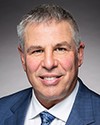Okay, I'll get started then.
Thank you very much for inviting me. It's a pleasure to be here.
Enviro-Stewards is an engineering company in Elmira, just north of Waterloo, Ontario, but we work across North America.
Today I'd like to outline a practical way to get to climate neutral and beyond for the agricultural sector. Our mission is to cultivate resilient business and improve lives. If you're interested, we have a TED talk on the development work we do in East Africa, but our paying work is in North America.
For example, Maple Leaf Foods is the world's first large food company to be carbon neutral. We got them there in November 2019. To do that, we assessed 35 facilities with them for conservation measures. Because they pursued a conservation-first approach, it's actually saving them money instead of costing them money to be carbon neutral. They're not waiting until 2030, 2040 or 2050. They're doing it now. It's actually economically viable to do it now.
I'd like to illustrate, first of all, a challenge I see in the typical procurement process. When people are buying water conservation for agri-food, or energy conservation, or food loss, typically the tendering is low cost. For example, we did 60 factories for York Region, for water conservation. We saved 36% of the water per factory, including many food and beverage manufacturers.
You can win many of the RFQs by saving 0% of the water. It's much easier to provide a quote to save 0% than 36%. As a consequence, anybody who's competent actually loses because they're at a competitive disadvantage in the typical tendering process. People think that the best energy audit to get is the cheapest one. The cheapest one will have the most expense when you get to the implementation, because the only way to do it is to implement what's always been done before.
You'll see in the technical brief I sent that we did one in London, Ontario, where we can heat an entire arena with the heat they're rejecting now by using a different approach from normal. What I want to put in your minds is that when you're doing your tendering, it's not the cost of the audit, it's the value of what's found that you need to do.
There was a bit of a better attempt when Agriculture and Agri-Food put out an RFP for a food waste challenge. It was better because it had the amount, so cost wasn't the issue. It was about who could give them the best proposal, and it gave the three criteria. I'll come back to that challenge in a minute.
I'll give a couple of examples in the food industry. The winery at Southbrook Vineyards is already LEED gold certified. It's organic, biodynamic and regenerative. They had a normal energy audit done. Their normal audit said they could save 5% with a 20-year payback. After that, we found and installed measures that cut the electricity by 40% and the gas by 40%. Interestingly, they had bought solar panels to replace the rest of their energy. They cancelled one-third of them. They didn't need them anymore because they're not using that energy. That saved half an acre of vineyard from getting covered with solar panels.
If you do a cheap audit, you're going to end up with the wrong solution at the end of the pipe. In their case, it was four months. It's two months if you value the wine that would have been lost by covering it with solar panels.
We're advocating this prevention-first approach. It's much more lucrative. That gets into the design of these programs. Most of the programs are designed to put money into capital and to basically make unattractive projects attractive. We did one project where, under one program, it was $2,500 to assess a factory for what should be done and $500,000 to implement it. All it did was implement stuff that would have been implemented anyway because they didn't have time to find what they should do.
If you take the time to find what you should do, you don't even need the capital funding. Our average payback for everything we've ever done is one year. If you find those ones, you don't need the capital, so it's much less expensive to provide the programs, and you can get what you're wanting to buy in the first place. I'm happy to comment on the design of these programs.
On social justice, after you reduce as much as you can.... In our own office, we've reduced our greenhouse gas footprint by 78% per employee through conservation. To get the last bit, you need to offset that. We sustainably offset it, but what are you going to do with that? Most of the programs in Canada are designed to benefit Canadians and Canadian companies instead of the people who are suffering from the climate change that we've caused in developing countries.
For example, we went to South Sudan and repaired solar panels on the roof of an orphanage. We get twice as much electricity, because there's twice as much sunlight in South Sudan. A generator was shut off that used to be running just to run the water pump. Instead of buying fuel for the generator, food is now bought for the kids. Socially, economically and environmentally, it's much better, but we get zero credit on any environmental program in Canada. We would get it only if we put it on our own roof in Elmira and had limited daylight all winter.
We have these XPrizes for carbon. The best way to sequester carbon is to just leave it as coal. It's never going to be more inert than that.
Planting trees is great. We should do that, but how about not cutting down trees in the first place? When you go to developing countries, they're cutting down trees to boil the water to make it safe to drink. If you just gave them safe water in the first place, you don't have to deforest, you don't have to....If we get smart about it, we actually get much better impacts on all of the sustainable development goals, not just one at a time.
On the food loss angle, this is probably your biggest opportunity. You probably know the big numbers, that one-third of all the food on the planet is wasted. If it were a country, the third-largest greenhouse gas emitter would be food loss, after China and the United States. The second-largest water consumer on the planet is the growing of food that's wasted. In Canada, it's $49 billion per year of lost value.
Almost 100% of the effort has been on how we divert that from landfill, because if it gets to landfill, it's going to turn to methane gas. If you divert 100% from landfill, you still waste one-third of the food. It's still the third-largest greenhouse gas emitter; it's still the second-largest water consumer on the planet, and you still lose most of that $49 billion. The only way to not do that is to not waste the food in the first place, and there are almost no programs targeting that.
We did Campbell Soup in Toronto. We first did energy and water, with a process integration. We found savings of $1.6 million per year of energy and water. Then we did food. We found them $700,000 per year of food that didn't have to be wasted. That food was going to a waste energy plant, but it's 4,000 tonnes less greenhouse gas to keep it as food, because it was in that supply chain.
We leveraged that, and the Walmart Foundation co-funded us to do 50 audits across Canada. This was a program administered by CFIA and the Provision Coalition. We went to 50 factories—



